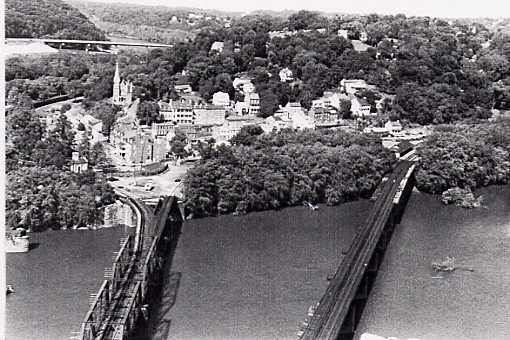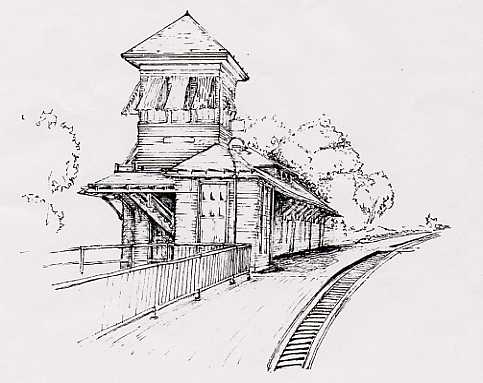Project in its first stage.. Restoration of building's
interlocking tower is proposed.. Park management to hear presentation in
August..
[By "Railroad Rob" Brzostowski] . . .
First, some history... It's 1894 and the Baltimore & Ohio Railroad
has just completed the relocation project of the main line through Harpers
Ferry, West Virginia. With this completion comes a brand new interlock
tower / train station. Designed by Francis Baldwin, the station complex
consists of a baggage/express office, two waiting rooms, a ticket office,
and a two-story interlock tower known as "HF." This tower is
located on the east end of the station. A pair of semaphores extend from
the north side of the tower. HF Tower protects the junction of the "Valley
Line" from Winchester, Virginia, and the main line from Baltimore
to Cumberland. An interesting feature of the physical plant is a double-slip
switch on the eastbound track. Located on the bridge crossing the Potomac
River, this switch forms the apex of this simple interlock.
Moving forward... It's now 1931 and the Baltimore & Ohio Railroad
has just completed its second realignment through Harpers Ferry. With this
new alignment, the main line project completed in 1894 has now been downgraded
to secondary status. The railroad has decided to keep the earlier alignment
as a backup in case there should be a problem. What is about to take place
is a big event. As people gathered around, the station is carefully lifted
up and slid over to the old double track mainline. The station is then
rolled some 600-plus feet west to the general area of its new home. Carefully,
the station is moved into its new spot.
As we reach the middle of the 1950's, we watch as the railroad removes
the two-story tower, leaving only the bottom half. The functions of the
operator are transferred to the ticket office. (The operators' positions
were abolished in 1986; functions were moved to Brunswick, Maryland.)

Harpers Ferry as seen from Maryland Heights
Let's move forward to today... Last August, the Harpers Ferry National
Historical Park received ownership of the train station and surrounding
property from CSX Transportation. Currently, the train station is in its
first phase of restoration. Drawings of the current condition are being
made by the Historic American Engineering Record (division of the U.S.
Department of Interior). The park archeologist is researching the history
of the station. At the end of August 2002, the archeologist and the HAER
team will hold a presentation to park management.
The park would like to reconstruct the interlock tower and restore the
existing station. (No physical changes will be seen for at least another
year.)

Drawing by Kris Key, HAER Team, depicting station with
rebuilt HF Tower
I have been asked by the Park Service and the HAER to assist in the
research and documentation of the train station. In the near future, I
will be writing more articles on the station and the progress of its restoration.
It is good to know that this piece of American railroading will be preserved
for generations to come.
[By Allen Brougham] . . .
The Northern Central Railroad Trail is my very favorite biking and hiking
haunt. Since the earliest days of its existence, I have faithfully nurtured
its presence with frequent pilgrimages along its entire length. The pages
of this publication from as far back as 1986 will attest to my love for
this local treasure. So it would be almost a non-event to report on yet
another adventure upon the trail... except that (for me) this particular
episode was sort of a first.
The date was Wednesday, June 19, and the event was an evening park-sponsored
bike ride (called "Bike Through History") north from Freeland,
Maryland, into Pennsylvania. The program is not new. Organized bike trips
have been in the offing for a number of years - they had simply not found
their way into my particular schedule. But now retired (a great advantage)
I decided to partake of this feature to see if I could learn anything new
(I did) and to share in communal fellowship with others who hold dear the
virtues of biking as a source of adventure. No preregistration was required
(but it was suggested that I call ahead to make sure, if the weather was
iffy), and I simply presented myself (and bike) at the designated assembly
point for the ride. It was now 6 P.M.; the event would take about two and
one-half hours from the time we departed.
Brenda, a naturalist for the Gunpowder Falls State Park, met us at the
Freeland parking area. Following introductions, she dutifully checked everyone's
tires for proper inflation. (An under-inflated tire can make biking mighty
rough.) My tires were OK, but some of the others needed air, which was
provided. She then asked everyone if they had a couple of dollars for Italian
Ice, to be purchased at our northern destination if desired. Then she gave
a brief history lesson on the Northern Central.
Yes, the weather was a little "iffy" that day. The distant
sounds of thunder could be heard from the direction we would be going -
but they abated as quickly as they appeared, and the skies were mostly
clear by the time we were set to leave.
Brenda told us that our first stop would be at the Mason-Dixon Line,
an uphill ride of about 12 minutes, and off we went with a group (at that
point) of 15 participants (but three had decided to leave earlier, to get
a head start), Not everyone kept the same pace, but all 15 of us arrived
at the first stop within a of couple minutes of the others. It was here
that Brenda gave a brief narrative on the history of the Mason-Dixon Line,
complete with pictures of some of the granite stones (imported from England)
that punctuate the line along its length. Most folks think of the Mason-Dixon
Line as separating Maryland from Pennsylvania (which it does), but the
line actually begins at the southwestern corner of Delaware to separate
that state from Maryland as well.
On the trail, it is at the Mason-Dixon Line that large signs depict
artwork depicting features of Maryland's and Pennsylvania's respective
portions (Monkton Station and Sparks Bank Nature Center in Maryland, and
New Freedom and Hanover Junction stations in Pennsylvania) along with notices
of current events, etc., applying to the trail on both sides of the line.
Being a perfectionist, I queried Brenda if indeed the signs are positioned
on the exact location of the state line. No, they aren't. The state line
is located about 50 feet north of the signs, the precise location being
marked by a metal pole from the railroad days.
Our next stop, about ten minutes north of the Mason-Dixon Line, was
at a location in New Freedom where there was once an interlocking tower.
She had a photo of the tower, too, with proof that this was its location
by the presence of houses in the background that are still there today.
This had been where steam helper engines would dwell to await their next
assignment. The flames from the engine's fire box would cast a flickering
light against the houses near the track, and from this phenomenon the nickname
"Flickerville" was coined to the neighborhood.
Coincidentally, all of the Liberty Limited Dinner Train equipment has
been removed from New Freedom. All that remains now are about four cabin
cars. (The Dinner Train ended service in September 2001.)
From Flickerville, we moved on (now it was downgrade) to the town of
Railroad, stopping within the park setting of this quaint town adorned
with historic buildings. It was here that Brenda told of historical accounts
of President Lincoln's travel upon the line en route to deliver his Gettysburg
Address (promising to render his speech to us later in the trip), and of
the journey of his funeral train a year and a half later.
Next it was on to our final stop at Glen Rock. But to the regret of
those who yearned for Italian Ice, it was learned that the eatery's machine
was out of service. It seems they recently changed locations, to a spot
across the street, and things were not ready to resume serving this reputed
delicacy. It was here that we joined up with the three who had biked on
ahead of us, and for this one-time occasion we had our full complement
of 18 participants.
Following our 25-minute stop (and with some in the party having left
early for the return ride) we made our way back up the grade to New Freedom.
Brenda had cautioned us earlier that the grade to New Freedom (in both
directions) could be a tad bit trying at times, and to this she suggested
that the bikers might get solace by saying, "helper engine, helper
engine," in rhythm as we pedaled. I tried it. Golly, by saying it
in a certain way, it resembles the chugging of a steam engine assaulting
the same grade.
The waning rays of sunlight shone against the distant clouds as we assembled
on the steps of New Freedom station, and it was here that Brenda recited
Lincoln's Gettysburg Address. These time-honored words had been delivered
in a speech of a mere two minutes, she noted, and never before or since
has such a powerful message been given. Brenda serves the Maryland park
system as a naturalist, but her role that evening as historian served the
program fittingly.
South of New Freedom (just beyond Flickerville), as the old rail line
reached its highest elevation, the trail enters an extremely shaded area
with large trees from the sides of a long cut overhanging the trail in
a surrealistic, tunnel-like manner. Sunlight is greatly obscured here on
the brightest of days, and at this moment, with the sun having already
set, the area was dark enough to appreciate having a light. Ten minutes
later, by now nearly nine o'clock, we arrived back in Freeland.
Most of the participants were "regulars" to Bike Through History,
a Wednesday evening program segmenting the entire length of the trail in
Maryland (plus the above portion in Pennsylvania) which will continue until
August 7.

